Introduction
There are many concepts of distance education, most of which boil down to the perception of it as a form of learning using indirect contact in the exchange of information between participants of this educational process (Dziewulak, 2012; Al- Khatir Al-Arimi, 2014). Key learning success factors of this type of education are the preparedness of stakeholders in the following dimensions: (1) psychological (a decrease in face-to-face contacts between the participants of the educational process, more contacts with the help of digital devices, as well as potential difficulties with concentration while physically being in a more comfortable environment for oneself); (2) professional (the level of training of the teaching staff for distance learning, their study of new opportunities that can improve the quality of the presentation of the material, as well as the qualifications of technical specialists providing the distance learning system in the institution, and the technical support’s willingness to assist users in any difficult situations), and (3) technical (availability of appropriate hardware and software) (Paliwoda-Pękosz, Stal i Wojtowicz, 2015; Adarkwah, 2021; Mintii, Shokaliuk, Vakaliuk, Merzlykin i Mintii, 2020).
In Ukraine, the research has been conducted for several years on the introduction and implementation of massive open online courses (Kukharenko, 2013; Sapargaliyev, 2014; Vakaliuk T. et al., 2020), and on distance education in the context of learning a specific subject (Nowacki i Banachowski, 2009; Syvyi, Mazbayev, Varakuta, Panteleeva i Bondarenko, 2020; Dovbenko, Naida, Beschastnyy, Bezverkhnia i Tsybulska, 2020). However, due to the pandemic, the study of distance education in Ukraine has become more acute, which has led to an increase in the number of research works related to distance learning (Kaliuzhka, et al., 2020; Bakhov, Opolska, Bogus, Anishchenko, & Biryukova, 2021; Shevchenko, Malysh, & Tkachuk-Miroshnychenko, 2021). Our study is one of the few that presents the bigger picture of learning during the pandemic, owing to embracing the data from several universities. In particular, the purpose of the study is to analyze the point of view of students on the level of readiness of the educational system for distance learning and prospects for the development of this type of learning in the future. We would like to answer the following research questions:
RQ1: Has the students’ attitude to remote learning changed as a result of the pandemic, and how?
RQ2: Which were the key factors that influenced the quality of distance learning?
RQ3: What forms of teaching would students prefer in the future?
The paper is organized as follows. The next section presents the research background that is followed by the description of the research method. Then, the results of empirical research are presented and discussed. The main research outcomes are summarized in the Implications and Conclusion sections.
Research Background
Distance learning before the pandemic
The scientific community in Europe has been conducting research on the readiness of different countries (like the United Kingdom, Latvia, Lithuania, Serbia, Poland, Belarus, Romania) for the distance learning process for a long time (Traxler, 2018; Vasilevska, Rivza, & Bogdan, 2017). Ukraine is no exception, and in this country this issue has been studied long before the pandemic. For example, in the years 2016-2019, a number of studies were carried out, the results of which showed that distance learning will enter common use in Ukraine in the future and that digital technologies will be gradually implemented in the educational process (Blayone, et al., 2018; Nosenko, Popel, & Shyshkina, 2019). The following advantages of distance learning were identified (Markova, Glazkova, & Zaborova, 2017; Pogorilyj, Dudikova, Yakymenko, Poyda, & Koval, 2020; Nenko, Кybalna, & Snisarenko, 2020; Kovbasnyuk & Styfanyshyn, 2020):
- possibility to choose the time and place of study (except for video conferencing and synchronous online lessons),
- flexibility,
- opportunities to save time (participants of the educational process do not spend time to get to the place of classes),
- savings (for transport, eating in restaurants, etc.).
However, a number of problems were also discovered that were related mainly to (Nenko, Кybalna, & Snisarenko, 2020; Didkivska, 2020; Prokopenko & Berezhna, 2020):
- insufficient qualifications of some teachers; reluctance to innovate; conservatism, which resulted in a low level of personal motivation to work with the use of remote technologies,
- excessive bureaucracy in implementing distance learning, which, together with the low financing of technology development and the need to modernize courses, did not allow for the creation of a real working model of remote education,
- lack of appropriate equipment and Internet access for students living in rural areas,
- poor awareness of distance learning,
- lack of teachers’ experience in developing teaching materials on their own.
Moreover, despite Ukraine’s unpreparedness in the aspects of distance education listed above, ready-made educational programs (like courses for the implementation of Massive Open Online Courses or Assessment Instrument of Technological Literacies in Makerspaces and FabLabs) aimed at obtaining the necessary competencies that were prepared for teachers to enhance their skills needed in distance learning activities (Blikstein, Kabayadondo, Martin, & Fields, 2017; Vakaliuk T. , et al., 2020; Strutynska & Umryk, 2016).
Distance learning in the time of the COVID-19 pandemic
At the moment, we can observe the impact of COVID-19 on many industries, however the biggest influence seems to be on the medicine and education branches (McKibbin & Fernando, 2020; Ferrel & Ryan, 2020). The educational systems of many countries were forced to adapt to the situation, and for the majority, distance education became the optimal way of education facilitation (Bojović, Bojović, Vujošević i Šuh, 2020; van Slyke, Clary, Tazkarji i Ellis, 2021; Assaf i Gan, 2021).
Ukraine was one of the many countries that, despite some experience in the distance education industry, was not ready for a quick transition to distance learning. However, over time, most students and teachers were able to adapt to the extraordinary conditions and continue to create an effective educational process (Nenko, Кybalna, & Snisarenko, 2020; Prokopenko & Berezhna, 2020).
At this stage of the research, the methods of analysis, systematization, and generalization of scientific literature on the problems of the introduction of distance learning were used in order to highlight the current areas of research, as well as a praximetric method for analyzing the pedagogical experience of implementing distance learning and identifying key issues in this area.
Research Method
The paper presents a preliminary result of joint research conducted by members of the faculty of Cracow University of Economics, Poland, and Zhytomyr Polytechnic State University, Ukraine.
In the first step of the research, the questionnaire in Polish has been developed on the basis of the Polish-Ukrainian team’s experience. At this stage, the method of concretization and systematization of theoretical knowledge was also used to develop the questionnaire. The questionnaire was distributed to a number of academics and students with request to check its understandability and clarity. The appropriate adjustment has been made. The questionnaire has been translated into the Ukrainian language and Ukrainian native speakers and bilingual speakers have checked the correctness of the translation. The Annex section contains the final survey questions relevant to the current study (translated into English). The survey in Ukraine was conducted in the late spring of 2021 (from May 25 to June 1), when all educational institutions already had more than a year of experience in implementing distance learning. The questionnaire was distributed to students via email. A convenience sample (Mesch, 2012) of students took part in the survey, i.e., the authors used their contacts to share the questionnaire with academics from various Ukrainian universities.
557 students of different degrees (bachelor’s, master’s, postgraduate) responded to the questionnaire. They represented 7 Ukrainian higher education institutions: National University of Life and Environmental Sciences (206), Zhytomyr Polytechnic State University (188), Kryvyi Rih State Pedagogical University (77), National Pedagogical University named after MP Drahomanov (36), Drohobych State Pedagogical University named after Ivan Franko (23), Melitopol State Pedagogical University named after Bohdan Khmelnytsky (16), and Uman State Pavel Tychyna Pedagogical University (11) (see Figure 1).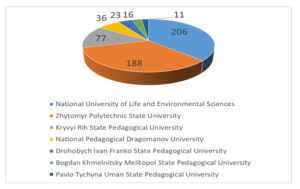
Fig. 1. Quantitative correlation of respondents
It should be noted that 28.5% of the respondents indicated that they have high quality technical support, 35% indicated that their quality of technical support is above average, 27.8% – medium quality, 6.8% – below average quality, and 1.8% – poor quality, respectively. This indicates that the vast majority of respondents have a sufficient level of technical support to ensure the effectiveness of the educational process.
Results
Attitudes towards distance learning (RQ1)
As for the attitudes of students to Internet communication, it was found that after the beginning of the pandemic there are less students who have a neutral attitude toward communication via the Internet and there is a slight increase in the number of students who prefer this form of communication. Comparative analysis of respondents’ answers is presented in Figure2.
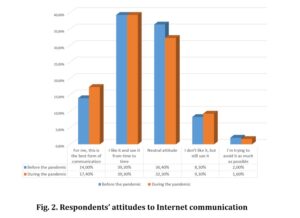
Fig. 2. Respondents’ attitudes to Internet communication
When trying to establish the respondents’ attitude to distance learning (not only in organized forms, but also, for example, educational videos on YouTube), it was found that for 15.1% of the respondents it was the best form of education before the pandemic, while during the pandemic the percentage of such students increased to 22.1%; 41.8% of respondents indicated that they like this form of education and they used it periodically before the pandemic, and 42.5% use it now. 28.5% of the students indicated a neutral attitude to this type of education before the pandemic, and 19.4% during the pandemic. Among the respondents there were those who did not like such training, but they used it before the pandemic – 10.4%, and during the pandemic – 11.8%. The same percentage of respondents (4.1%) indicated that they do not like such training and they avoid it both before the pandemic and during the pandemic. As a result, we can conclude that there is an increase in the respondents’ level of acceptance of this type of learning.
As far as the experience of the respondents’ interaction with various forms and means of distance learning before and during a pandemic is concerned (Table 1), it was found that about half of the respondents had experience of using online conferences and webinars before the pandemic, while during the pandemic this increased to about four-fifth. Besides, the number of respondents working on streaming platforms increased from one third to two thirds during the pandemic. Among the distance learning tools that were most in demand among students were learning management systems (LMS), which are commonly used not only for distance learning, but also for blended learning.
Table 1: Experience of students’ interaction with different forms and tools of distance learning
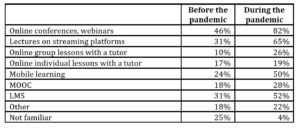
Key factors influencing the quality of distance learning (RQ2)
According to the survey results, lectures, seminars and consultations were more effective in distance learning than in full-time study, while practical classes and laboratory work were less effective. It is worth noting that for each form of classes, on average a quarter do not see the difference between full-time and distance forms of their organization. Comparative analysis of the respondents’ answers is presented in Figure 3.
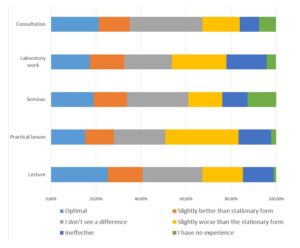
Fig. 3: Students’ evaluation of the effectiveness of various forms of distance learning
Factors in the quality of education include typical interactions (teamwork, interaction with the lecturer, interaction with other students), understanding of the material, interest in involvement and the level of comfort during the lesson. On average, two fifths of the respondents do not see the difference between stationary and distance learning for these factors but for the latter one, for which one fifth of the respondents saw no difference. The level of comfort during classes has improved during distance learning (this is evidenced by the answers of two thirds of the respondents). Comparative analysis of the respondents’ answers is presented in Figure 4.
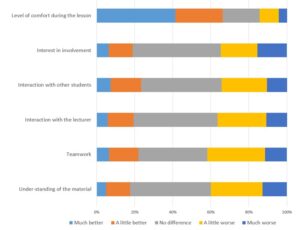
Fig. 4: Students’ assessment of the impact of distance learning on educational quality factors
On average, 42% of the respondents do not see a difference in the effectiveness of the assessment of knowledge and skills using various forms. Comparative analysis of the respondents’ answers is presented in Figure 5.
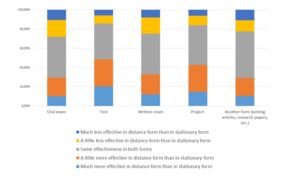
Fig. 5: The effectiveness of various knowledge assessment forms in the context of distance learning
Forms of teaching that students would prefer in the future (RQ3)
An interesting fact is that on average 71% of the respondents agreed that each of the proposed forms of learning can be used in the distance learning mode in the future, at least sometimes. Comparative analysis of the respondents’ answers is presented in Table 2.
Table 2: Students’ assessment of the potential use of various forms of distance learning in the future
Analysis and Discussion
After analyzing the results of the survey, we could conclude that:
- Not all students studying in higher education institutions of Ukraine have the sufficient technical support for distance learning; about 9% of the respondents answered that their technical support is insufficient (it should be noted that the questionnaire was distributed via e-mail, and therefore the potential respondents who have this problem could not have had access to the questionnaire).
- Despite the fact that students’ attitudes towards distance learning have not changed significantly, students’ awareness of various forms and means of distance learning has greatly increased.
- There is a significant increase in the level of students’ interaction with various forms and tools of distance learning during the pandemic compared to the period before the pandemic.
- According to respondents, lectures, seminars and consultations are more effective in distance learning than in full-time, but lessons such as practical or laboratory classes in distance form are not welcomed by students.
- Most of the students don’t see a difference or feel an increase in the quality of education or the effectiveness of various knowledge assessment forms in the context of distance learning.
- The level of comfort during the lesson for students became much better during distance learning.
- The vast majority of respondents agreed that each of the proposed forms of distance learning can be used in the future at least from time to time.
- The majority of students predicted the use of hybrid learning in future education.
Implications
This study has demonstrated the view of students of selected higher education institutions in Ukraine on the introduction of distance learning in the context of the pandemic. The results of this study can be used to create a comparative description of the conditions for the introduction of distance learning in different countries. The results showed that most Ukrainian students are accustomed to distance education and are ready to use elements of distance learning in the future. This allows teachers to assess the prospects of developing educational institutions and adapting curricula to the current educational needs of students.
Conclusion
The article analyzed the opinion of 557 Ukrainian students regarding the current state of distance education and the prospects for its development. At the present stage of introduction of distance learning technologies in the educational process of higher education institutions in Ukraine, we can conclude that students are ready for distance learning and have the technical capacity to do so. In addition, the pandemic situation has taken universities to a new level, as evidenced by a survey on what form of education is possible after the end of the pandemic. Most students agree that after the end of the pandemic, it is possible to introduce at least some elements of distance learning by means of hybrid learning. In future research, we would like to conduct a comparative study on the basis of data from Ukraine and Poland.
Acknowledgments
The questionnaire items were developed by Svitlana Didkivska, Dariusz Dymek, Mariusz Grabowski, and Grażyna Paliwoda-Pękosz from the Cracow University of Economics, Poland.
This publication has been financed by the subsidy granted to the Cracow University of Economics, Poland.
References
- Adarkwah, M. A. (2021). ‘I’m not against online teaching, but what about us?’. Education and Information Technologies, 26(2), 1665-1685.
- Al-Khatir Al-Arimi, A. (2014). ‘Distance Learning’. Procedia – Social and Behavioral Sciences, 152, 82-88.
- Assaf, N., & Gan, D. (2021). ‘Environmental education using distance learning during the COVID-19 lockdown in Israel’. Perspectives in Education, 39, 257 – 276.
- Bakhov, I., Opolska, I., Bogus, M., Anishchenko, V., & Biryukova, Y. (2021). ‘Emergency distance education in the conditions of COVID-19 pandemic: Experience of Ukrainian universities’. Education Sciences, 364. doi:10.3390/educsci11070364
- Blayone, T., Mykhailenko, O., Kavtaradze, M., Kokhan, M., vanOosteven, R., & Wendy, B. (2018). ‘Profiling the digital readiness of higher education students for transformative online learning in the post-soviet nations of Georgia and Ukraine’. International Journal of Educational Technology in Higher Education, 15(37). doi:https://doi.org/10.1186/s41239-018-0119-9
- Blikstein, P., Kabayadondo, Z., Martin, A., & Fields, D. (2017). ‘An assessment instrument of technological literacies in makerspaces and FabLabs.’ Journal of Engineering Education, 106(1), 149-175.
- Bojović, Ž., Bojović, P., Vujošević, D., & Šuh, J. (2020). ‘Education in times of crisis: Rapid transition to distance learning’. Computer Applications in Engineering Education, 1467 – 1489. doi:10.1002/cae.22318
- Didkivska, S. (2020). ‘Аналіз змішаного навчання та ефективність його компонентів під час впровадження в освітній процес закладів вищої освіти (Analysis of blended learning and the effectiveness of its elements in the implementation of the education process at universities)’. In N. Astrahan, T. Vakaluk, & L. Vojnalovych (Eds.), Теоретичні основи та прикладні аспекти вивчення дискурсу (Theoretical foundations and applied aspects of the study of discourse) (pp. 141-158). Zhytomyr: Zhytomyr Polytechnik State University.
- Dovbenko, S., Naida, R., Beschastnyy, V., Bezverkhnia, H., & Tsybulska, V. (2020). ‘Problem of resistance to the introduction of distance learning models of training in the vocational training of educators’. International Journal of Learning, Teaching and Educational Research , 1 – 12. doi:10.26803/ijlter.19.2.1
- Dziewulak, D. (2012). ‘Kształcenie na odległość w wybranych państwach europejskich’. Analizy BAS, 18, 1-11.
- Ferrel, M., & Ryan, J. (2020). ‘The impact of COVID-19 on medical education’. Cureus, 1-37. doi:10.3386/w26947
- Kaliuzhka, N., Samoilenko, N., Zdanevych, L., Kyselova, O., Terentieva, N., & Koval, D. (2020). ‘Distance education as an alternative form of learning during a pandemic’. Systematic Reviews in Pharmacy, 458 – 46. doi:10.31838/srp.2020.9.64
- Kovbasnyuk, N., & Styfanyshyn, I. (2020). ‘Distance Learning’. Proceedings of the conferences of the Youth Scientific League, 38-39.
- Kukharenko, V. (2013). ‘Designing massive open online courses’. 9th International Conference on Information and Communication Technologies in Education, Research and Industrial Applications: Integration, Harmonization and Knowledge Transfer, 273 – 280.
- Markova, T., Glazkova, I., & Zaborova, E. (2017). ‘Quality issues of online distance learning’. Procedia-Social and Behavioral Sciences, 237, 685-691.
- McKibbin, W., & Fernando, R. (2020). ‘The economic impact of COVID-19’. (R. Baldwin, & B. Weder di Mauro, Eds.) Economics in the Time of COVID-19, 45-51.
- Mesch, G. (2012). ‘E-Mail Surveys’. Handbook of Survey Methodology for the Social Sciences. doi:doi.org/10.1007/978-1-4614-3876-2_18
- Mintii, I., Shokaliuk, S., Vakaliuk, T., Merzlykin, O., & Mintii, M. (2020). ‘Development of a Standard Moodle Course to Optimize the Teacher’s Work in Distance Education’. Universal Journal of Educational Research, 8(12), 6659-6666. doi:10.13189/ujer.2020.081230
- Nenko, Y., Кybalna, N., & Snisarenko, Y. (2020). ‘The COVID-19 Distance Learning: Insight from Ukrainian students’. Revista Brasileira de Educação do Campo, 5, 15-17.
- Nosenko, Y., Popel, M., & Shyshkina, M. (2019). ‘The state of the art and perspectives of using adaptive cloud-based learning systems in higher education pedagogical institutions (the scope of Ukraine)’. Higher and secondary school pedagogy(52), 56-69. doi:10.31812/pedag.v52i0.3776
- Nowacki, J., & Banachowski, L. (2009). ‘Application of e-learning methods in the curricula of the faculty of computer science.’ Lecture Notes in Electrical Engineering, 11, 161 – 171. doi:10.1007/978-0-387-76483-2_14
- Paliwoda-Pękosz, G., Stal, J., & Wojtowicz, L. (2015). ‘Application of ICT Tools in Enhancing Education in Information Society’. Proceedings of 9th European Conference on IS Management and Evaluation (ECIME), 160-169 .
- Pogorilyj, V., Dudikova, L., Yakymenko, O., Poyda, S., & Koval, B. (2020). ‘Improvement of Learning Outcomes in Educational Process of Interns-Pharmacists using Distance Learning Elements’. Information Technologies and Learning Tools, 72(2), 236-249.
- Prokopenko, I., & Berezhna, S. (2020). Higher Education Institutions in Ukraine during the Coronavirus, or COVID-19, Outbreak: New Challenges vs New Opportunities. Kharkiv: Published by Editura Lumen, Asociatia Lumen Lumen Publishing House.
- Sapargaliyev, D. (2014). ‘Forced necessity: MOOCs in post-soviet countries’. Proceedings of 9th International Conference on e-Learning, 165 – 168.
- Shevchenko , V., Malysh, N., & Tkachuk-Miroshnychenko, O. (2021). ‘Distance learning in Ukraine in COVID-19 emergency’. Open Learning. doi:10.1080/02680513.2021.1967115
- Strutynska, O., & Umryk, M. (2016). ‘The use of MOOCs for training of the future computer science teachers in Ukraine’. Distance education research fields and methods, 297-319.
- Syvyi, M., Mazbayev, O., Varakuta, O., Panteleeva, N., & Bondarenko, O. (2020). ‘Distance learning as innovation technology of school geographical education’. 3rd International Workshop on Augmented Reality in Education. 2731, pp. 369 – 382. Kryvyi Rih: AREdu.
- Traxler, J. (2018). ‘Distance learning—Predictions and possibilities’. Education Sciences, 8(1), 35. doi:10.3390/educsci8010035
- Vakaliuk, T., Yefimenko, A., Bolotina, V., Bailiuk , Y., Pokotylo, O., & Didkivska, S. (2020). ‘Using massive open online courses in teaching the subject “computer networks” to the future IT specialists’. Proceedings of 16th International Conference on ICT in Education, Research and Industrial Applications. Integration, Harmonization and Knowledge Transfer, 665 – 676.
- van Slyke, C., Clary, G., Tazkarji, M., & Ellis, S. (2021). ‘Distress, eustress, and intentions to continue distance learning in the context of rapid shifts to online courses’. SIGED International Conference on Information Systems Education and Research , 45 – 51.
- Vasilevska, D., Rivza, B., & Bogdan, R. (2017). ‘Evaluation of readiness for distance education of students in European Universities’. Broad Research in Artificial Intelligence and Neuroscience, 8(1), 35-41
Annex
Questionnaire items relevant to the current study.
PART 1 – SOME INFORMATION ABOUT YOURSELF
- Gender: (male/female/prefer not to say)
- Chose your university: ( National University of Life and Environmental Sciences/Zhytomyr Polytechnic State University/Kryvyi Rih State Pedagogical University/National Pedagogical Dragomanov University/Drohobych Ivan Franko State Pedagogical University/Bogdan Khmelnitsky Melitopol State Pedagogical University/Pavlo Tychyna Uman State Pedagogical University)
- Study level: (undergraduate/MA studies/doctoral studies)
- Year of study: (first/second/third/fourth/fifth or higher)
PART 2 – BEFORE AND DURING THE PANDEMIC
- What is your attitude towards distance learning (not only organized forms but also e.g. training videos on Youtube)? (I don`t like it and try to avoid/ I don`t like it but I use it/neutral/ I prefer it/ I definitely prefer it)
- Before the pandemic
- During the pandemic
- What distance learning methods did you use before the pandemic? Several answers are possible. (none/individual consultations via a communicator/online classes using a communicator/blended-learning courses on Moodle/publicly available online courses (MOOCs)/mobile-learning/lectures on streaming platforms/online conferences, webinars/other).
- What distance learning methods did you use during the pandemic? Several answers a possible. (none/individual consultations via a communicator/online classes using a communicator/blended-learning courses on Moodle/publicly available online courses (MOOCs)/mobile-learning/lectures on streaming platforms/online conferences, webinars/other).
- What classroom (face-to-face) activities did you participate in during the pandemic? (I did not participate/individual classes/classes in a subgroup/classes in the dean’s group)
- How has your mental health changed after switching to distance learning?(significantlydeteriorated/worsened/nochange/improved/significantly improved).
- Evaluate the effectiveness of the given forms of distance learning activities (classes (for practical work)/lectures/seminars/laboratories/consultations) in relation to traditional learning on a scale (did not participate/unsuitable/slightly worse/same effectiveness/slightly better/optimal).
PART 3 – AFTER THE PANDEMIC
- Which form of classes (classes (for practical work)/lectures/seminars/laboratories/ consultations) could be conducted remotely, in your opinion, after the pandemic is over? (Evaluate each of them on the scale: I don’t have an opinion/unsuitable/“it`s ok”/preferred form).
- What do you think will be the trend in forms of education after the end of the pandemic? I think it will be (complete abandoning of the remote form of learning/frequent use of the distance learning form/hybrid form of learning/very frequent use of distance learning/spreading the popularity of using fully distance learning courses).
- In your opinion, what form of studies will be preferred by future students after the pandemic is over? (traditional (face-to-face classes with the occasional use of distance learning)/hybrid (face-to-face classes with significant use of distance learning)/remote (full studies using only distance learning)).
- What do you think is the attitude of people who came into contact with distance learning during the pandemic to continue learning in this form? (avoidance/tolerance/preferring).
- In your opinion, how does the remote form of classes affect the quality of education (in the field of: understanding of the material/teamwork/interaction with the lecturer/interaction with other students/commitment during classes/feeling of comfort during classes). Rate it on the scale (much worse/worse/no difference/better/much better).
- In your opinion, how do remote methods of completing the final exams (oral exam/multiple-choice test/exam with open questions/project and its presentation/written final work) affect the effectiveness of the verification of knowledge and skills? Rate on the scale (unsuitable/ decreases/no difference/improves/optimal)









